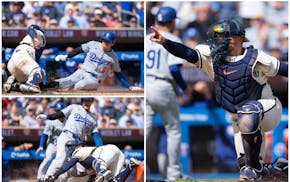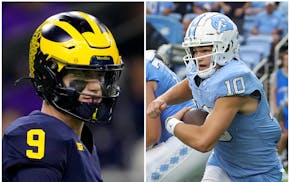Minnesota United FC put on quite a theatrical production for the unveiling of the team's inaugural kit, or uniform, to those not yet fluent in soccer lingo.
(Don't worry, I had to have it explained to me.)
Music blared as fans held up phones to snap photos. Except a smoke machine must have been turned to max capacity, and the cloud became so thick that nobody could see players onstage modeling their new duds.
Alas, the smoke eventually cleared, and the party raged.
Hiccups are inevitable, maybe even expected, with any expansion team. Judging by the line of fans that stretched around the block at the kit unveiling, Major League Soccer picked a welcoming new home.
So how does United find its footing in a crowded sports market with five other existing pro franchises and a major Division I athletic program? Those operations are all vying for fan interest, corporate dollars and media coverage.
Novelty will provide a boost the first season. Curiosity over a new team or new stadium always sells well.
I've chronicled Twin Cities sports for nearly two decades, but I admittedly have limited knowledge of MLS or soccer in general. In that regard, that should put me in the target growth demographic — a soccer newbie who's genuinely intrigued by the club.
The Loons start with strength in fan support. They have two robust and loyal fan groups that gave lower-tier pro soccer in Blaine a festive atmosphere.
Boisterous soccer crowds create a party vibe that people want to join, or at least observe, especially if they are new to the sport. United games in Blaine were raucous but family friendly, a hip scene much like what the St. Paul Saints have perfected.
That carry-over provides a solid foundation, but the Loons have an opportunity to expand their fan base beyond die-hards and millennials. The Twin Cities is home to diverse communities that embrace soccer as a primary sport. Building an intimate stadium in St. Paul can bring those communities together for a common purpose.
"The challenge for us to engage those audiences is to tell a story that's relevant to them, that they want to be a part of and follow," United President Nick Rogers said.
Marketing and branding will be critical in building a fan base. United players aren't household names. The team spent most of preseason training outside of Minnesota with limited media exposure.
To steal a Twins slogan, the Loons need to help fans get to know 'em.
"At this level, we have to cast a wider net and become a little bit more mainstream team," Rogers said.
Securing a sponsorship with Target Corporation will help that exposure. With Target's logo featured prominently on United's jerseys (sorry, shirts), that partnership should increase brand recognition to a broader audience.
Rogers describes Target's support as "proof of concept."
"We have believed in this for a long time," he said. "We've spent the last four years proving that there is a market for pro soccer."
Long-term viability hinges on many factors: on-field success, price of tickets, entertainment value, fan engagement inside the stadium, marketing.
Many will give the team a chance out of curiosity. Winning might be secondary initially, but over time, success will determine whether some fans stick around.
"We have to put a credible product on the field," Rogers said.
Good word, credible. That will go a long way in showing United is an organization being built for the long haul.
Chip Scoggins • chip.scoggins@startribune.com

Scoggins: Finch feeling heat of the Suns as playoff battle looms
Scoggins: Why 'championship or bust' fits these Wolves

Scoggins: Anatomy of a game-saving play as Correa throws out Ohtani


